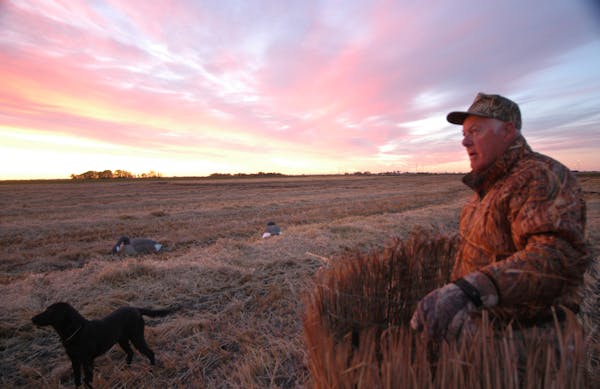Eleven-year-old Grace Rodemann, cradling her 20-gauge shotgun, scanned the clear morning sky for ducks Saturday on a dank, mosquito-laden marsh near the Minnesota River — her first-ever hunt.
"I want ducks to fly in,'' she said, hunkered in a duck boat with her mentor, John Wartman, 47, of Waconia, and his eager 1-year-old black Lab, Drake. Nearby in a canoe, her grandfather, Bill Thompson, 65, of Pelican Rapids, and I watched.
A few teal and wood ducks did fly in, but they all jetted away unscathed.
"I had fun,'' Grace said afterward. "I liked shooting at the ducks. What I didn't like was their speed.''
Spoken like a true waterfowler.
Grace was among an estimated 5,000 youngsters age 15 and under who endured summerlike heat and humidity to take a crack at ducks and geese on Minnesota's 18th annual Youth Waterfowl Day. The purpose is to give kids a taste of waterfowling, with the hope that some will take up the sport. It is one of many youth hunting events — including pheasant, turkey and deer hunts — offered in Minnesota, an evolution that began decades ago to try to stem the decline of hunter numbers and to provide opportunities that family members, for myriad reasons, sometimes no longer give.
But is it working? Will Grace and the other young hunters who hunkered in blinds Saturday become duck hunters, and remain avid hunters when they are 20, 30 and 40 years old? How do parents, other hunters and natural resource agencies keep those kids hunting? In fact, can they do anything to influence that course?
The answers are as elusive as blue-winged teal rocketing past decoys.
Family support
"The most important reason why people become hunters is because they are mentored and influenced by an existing hunter, typically a family member,'' said Jay Johnson, Department of Natural Resources hunter recruitment and retention program coordinator.
Grace's dad, Phil, didn't grow up in a hunting family and doesn't hunt. But Grace expressed an interest, so she signed up for a Minnesota Waterfowl Association program that included a gun safety class and culminated with Saturday's youth hunt at the Minnesota Valley National Wildlife Refuge. Twelve kids hunted there, bagging 21 ducks and three geese.
Grace said she decided to try hunting after hearing hunting stories from her grandfather, a lifelong hunter, and a young friend who comes from a hunting family. "If she enjoys it, I'll support it,'' Phil Rodemann said. "I hope she keeps doing it.''
But both he and Grace's grandfather agreed that giving her opportunities will determine whether she becomes a lifelong hunter.
"It's key that there is someone for them to go hunting with, because they're not going to be going out by themselves,'' Phil Rodemann said.
Thompson said youths must have the desire to hunt.
"Grace has shown that desire. So now I think it's just exposure. I'll do whatever I can do to provide the opportunities for her.''
In the case of duck hunting, the DNR's Johnson said yes, there need to be enough ducks over hunting blinds to attract interest, and hunters need access to a place to hunt. But ultimately social factors trump those issues.
"Over the past decade, we've tried to do everything we can to make it as easy as possible for a person to start hunting,'' he said. "The problem is we don't have control over the many social variables that determine whether or not a person becomes a hunter. The major constraints are work and family obligations. How do we impact that?''
Urbanization, an aging population of hunters, changing demographics — including a growing population of minorities, who often don't have hunting traditions — all are impacting hunter numbers, Johnson said.
Said Grace's grandfather: "All the competition with other activities — that's a huge impediment.''
The 'churn factor'
Unlike other states, Minnesota's overall hunter numbers have remained fairly stable at around 600,000. But waterfowl hunter numbers, in particular, have fallen from about 140,000 in the 1960s to 73,000 in 2010 before rebounding to 90,000 last year. Youth Waterfowl Day was launched nationally in hopes of changing that trend.
"People incorrectly expect this is the answer to youth waterfowl hunter recruitment,'' Johnson said. "It's not a silver bullet. It's just a single activity to be used by parents or guardians in a process to recruit a hunter.''
And, even after 18 years, Johnson said the DNR doesn't know what effect, if any, the youth hunt has had on recruiting hunters. Looking at hunting license or duck stamp sales over that period doesn't help, partly because hunters routinely drop in and out of the sport.
For example, 1,307 16-year-olds bought state duck stamps in 2000. But over the next 12 years, that age group showed wild fluctuations in the purchase of duck stamps. As 19-year-olds, they bought 2,839, and last year, as 28-year-olds, and they bought 2,160. Officials call it the "churn rate,'' and it's dramatic. Very few hunters buy licenses every year. From 2007 to 2011, only about 28 percent of waterfowl hunters bought duck stamps every year, and nearly one-third bought duck stamps just one of those years.
The numbers are similar for hunters of other species. Which makes hunter recruitment a moving target.
Did Saturday's morning hunt strike a chord with Grace, and will she grow up to be a hunter and conservationist? "Yes, definitely,'' she predicted. "I think it's a great sport.''
Meanwhile, Grace — who wore extra padding to cushion her shoulder from the shotgun recoil — said she wants to try bow hunting for whitetails.
"I've always wanted to go deer hunting,'' she said. "[A bow] has no kick, and you don't need ear plugs.''

